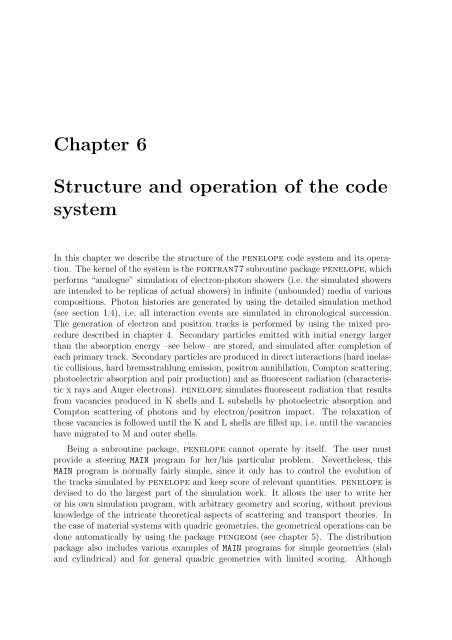PENELOPE 2003 - OECD Nuclear Energy Agency
PENELOPE 2003 - OECD Nuclear Energy Agency
PENELOPE 2003 - OECD Nuclear Energy Agency
You also want an ePaper? Increase the reach of your titles
YUMPU automatically turns print PDFs into web optimized ePapers that Google loves.
Chapter 6<br />
Structure and operation of the code<br />
system<br />
In this chapter we describe the structure of the penelope code system and its operation.<br />
The kernel of the system is the fortran77 subroutine package penelope, which<br />
performs “analogue” simulation of electron-photon showers (i.e. the simulated showers<br />
are intended to be replicas of actual showers) in infinite (unbounded) media of various<br />
compositions. Photon histories are generated by using the detailed simulation method<br />
(see section 1.4), i.e. all interaction events are simulated in chronological succession.<br />
The generation of electron and positron tracks is performed by using the mixed procedure<br />
described in chapter 4. Secondary particles emitted with initial energy larger<br />
than the absorption energy –see below– are stored, and simulated after completion of<br />
each primary track. Secondary particles are produced in direct interactions (hard inelastic<br />
collisions, hard bremsstrahlung emission, positron annihilation, Compton scattering,<br />
photoelectric absorption and pair production) and as fluorescent radiation (characteristic<br />
x rays and Auger electrons). penelope simulates fluorescent radiation that results<br />
from vacancies produced in K shells and L subshells by photoelectric absorption and<br />
Compton scattering of photons and by electron/positron impact. The relaxation of<br />
these vacancies is followed until the K and L shells are filled up, i.e. until the vacancies<br />
have migrated to M and outer shells.<br />
Being a subroutine package, penelope cannot operate by itself. The user must<br />
provide a steering MAIN program for her/his particular problem. Nevertheless, this<br />
MAIN program is normally fairly simple, since it only has to control the evolution of<br />
the tracks simulated by penelope and keep score of relevant quantities. penelope is<br />
devised to do the largest part of the simulation work. It allows the user to write her<br />
or his own simulation program, with arbitrary geometry and scoring, without previous<br />
knowledge of the intricate theoretical aspects of scattering and transport theories. In<br />
the case of material systems with quadric geometries, the geometrical operations can be<br />
done automatically by using the package pengeom (see chapter 5). The distribution<br />
package also includes various examples of MAIN programs for simple geometries (slab<br />
and cylindrical) and for general quadric geometries with limited scoring. Although
















